
new home sewing machine instruction manual
Discover your new home sewing machine’s full potential with our comprehensive manual. Perfect for beginners and experienced sewists alike!
Welcome to the New Home Sewing Machine‚ a versatile and reliable tool designed for household use. Known for its durability and ease of operation‚ this machine offers a variety of stitches and features to suit both beginners and experienced sewers. Perfect for sewing‚ repairing‚ and crafting‚ it ensures high-quality results with minimal effort. The comprehensive instruction manual guides users through setup‚ maintenance‚ and troubleshooting‚ making it an essential resource for optimal performance.
1.1 Overview of the Machine and Its Features
The New Home Sewing Machine is a versatile‚ household-use appliance designed for sewing‚ repairing‚ and crafting. It features multiple stitch options‚ automatic tension control‚ and an LED light for improved visibility. The machine is compatible with various presser feet and attachments‚ making it ideal for both basic and advanced projects. Its durable construction and user-friendly design ensure smooth operation and consistent results.
1.2 Importance of Reading the Instruction Manual
Reading the New Home Sewing Machine instruction manual is essential for understanding its operation‚ features‚ and maintenance. It provides safety guidelines‚ troubleshooting tips‚ and step-by-step instructions for optimal use. Proper usage ensures longevity‚ prevents damage‚ and helps users maximize the machine’s capabilities. Always refer to the manual before attempting repairs or adjustments to avoid accidents and maintain performance.
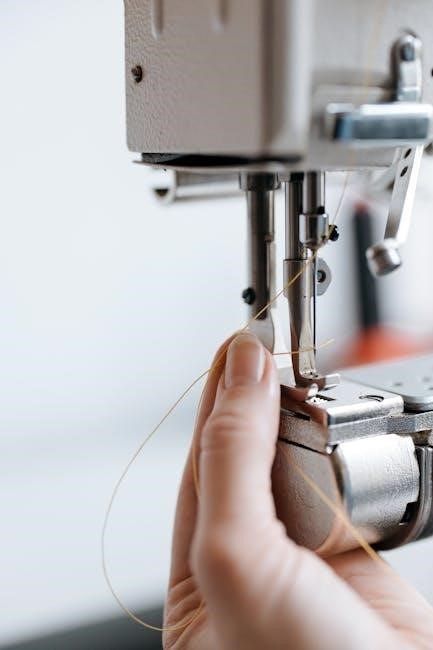
Unboxing and Initial Setup
Unboxing your New Home Sewing Machine reveals the machine‚ accessories‚ and instruction manual. Carefully review the manual for setup guidance to ensure proper assembly and function.
2.1 What’s Included in the Box
Your New Home Sewing Machine package includes the machine‚ instruction manual‚ standard presser foot‚ bobbin‚ needles‚ and power cord. Additional accessories like specialized feet may be purchased separately. Ensure all items are accounted for before setup. The manual provides detailed instructions for assembly and operation‚ ensuring a smooth start to your sewing journey.
2.2 Setting Up the Machine for First Use
Place the New Home Sewing Machine on a stable surface and plug in the power cord. Carefully unpack all components and ensure they are undamaged. Wind the bobbin and thread the machine as instructed in the manual. Familiarize yourself with the controls and presser feet before starting. Always read the manual thoroughly to understand safety guidelines and operation tips for optimal use.
2.3 Safety Precautions and Guidelines
Ensure the New Home Sewing Machine is placed on a stable‚ flat surface. Keep ventilation openings free from lint and dust to prevent overheating. Avoid inserting objects into the machine or using damaged cords. Always switch off the machine when adjusting the needle area or changing settings. Use only recommended attachments and keep the machine out of children’s reach. Read the manual thoroughly before operation.
Threading and Bobbin Setup
Mastering threading and bobbin setup ensures smooth sewing. Follow the manual’s step-by-step guide for proper threading techniques and correct bobbin winding to achieve consistent stitches.
3.1 Step-by-Step Threading Instructions
Begin by placing the thread on the spool pin and pulling it gently through the machine’s tension discs. Guide the thread through the take-up lever‚ ensuring it rests in the correct groove. Next‚ thread the needle from front to back‚ leaving a small loop. Pull the thread to secure it‚ ensuring no knots or twists. Always refer to the manual for specific diagrams to avoid errors; Proper threading ensures smooth operation and prevents thread breakage during sewing. Keep the thread taut but not overly tight for optimal performance.
3.2 Proper Bobbin Winding Techniques
Place the bobbin on the winder‚ aligning the notch with the pin. Use the same thread as the top thread‚ ensuring it’s not twisted. Wind slowly‚ keeping the thread taut but not too tight. Stop when the bobbin is 2/3 full. Cut the thread‚ leaving a tail. Insert the bobbin into the machine‚ following the manual’s diagrams for proper seating. Avoid overfilling to prevent jams.
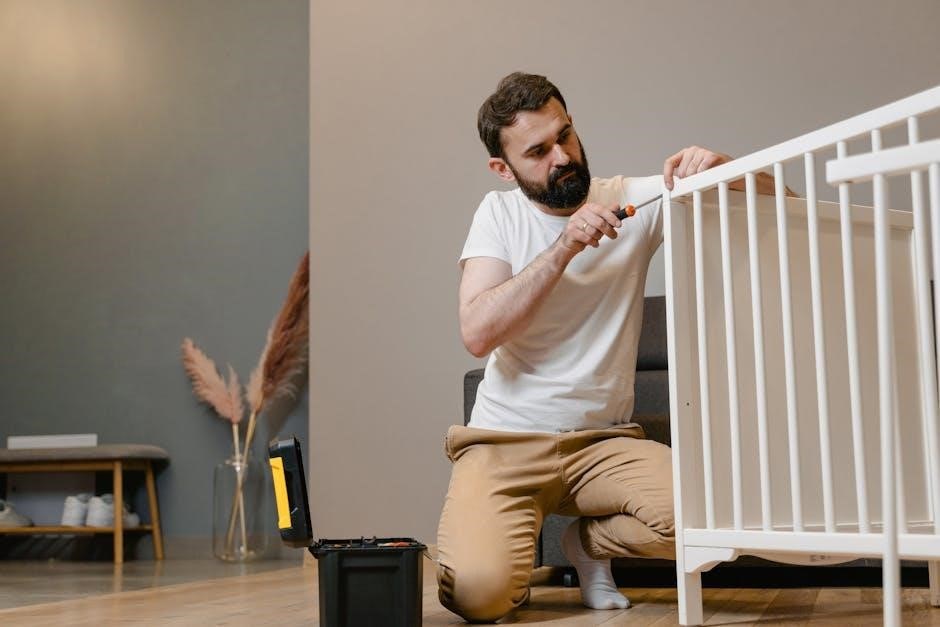
Understanding the Stitch Selector
The stitch selector allows you to choose from various stitch types‚ including straight‚ zigzag‚ and decorative options. It enables customization of stitch length and width for different fabrics and projects‚ ensuring precise control over your sewing results.
4.1 Types of Stitches Available
The New Home sewing machine offers a variety of stitches‚ including straight‚ zigzag‚ and decorative options. These stitches cater to different sewing needs‚ from basic repairs to intricate embroidery. The machine also features stretch stitches for elastic fabrics and reinforcement stitches for heavy-duty projects‚ ensuring versatility for any sewing task.
4.2 Adjusting Stitch Length and Width
Adjust stitch length and width using the control dials or digital interface‚ depending on your model. Longer stitches are ideal for heavy fabrics‚ while shorter ones suit delicate materials. Use the width adjustment for zigzag or decorative stitches. Always test adjustments on scrap fabric before sewing your final project for precise results;
Using the Machine for Basic Sewing
Place fabric under the needle‚ align edges‚ and gently guide it for straight lines. Use backstitch for secure seams and manage fabric smoothly for even stitching.
5.1 Sewing Straight Lines and Turning Fabric
Start by aligning fabric edges under the needle. Use the edge guide to maintain straight lines. Gently guide the fabric with your hands‚ keeping it taut. When turning fabric‚ stop with the needle down‚ lift the presser foot‚ and pivot the fabric as needed. This ensures smooth transitions and precise stitching without distortion.
5.2 Backstitching for Secure Seams
Backstitching at the beginning and end of seams ensures durability. Start by sewing 2-3 reverse stitches‚ then continue forward. Use the machine’s reverse stitch button to reinforce seams. This technique prevents fraying and strengthens stress points‚ especially on heavy fabrics or high-stress areas. Keep fabric steady and maintain consistent tension for secure‚ professional-looking results.
5.3 Managing Fabric While Sewing
Always guide fabric smoothly under the presser foot to maintain even feeding. Use the machine’s built-in guides or attachable accessories for precise control. Keep fabric taut but not stretched to prevent distortion. For thick or slippery materials‚ consider using a walking foot or Teflon foot. Proper fabric management ensures straight seams and prevents bunching or dragging during sewing.

Attachments and Accessories
The machine comes with various attachments like presser feet for zippers‚ hems‚ and decorative stitching; These accessories enhance functionality‚ allowing precise control over different fabric types and sewing techniques.
6.1 Overview of Presser Feet and Their Uses
Presser feet are essential accessories for the New Home sewing machine‚ designed to handle specific tasks. The zipper foot is ideal for sewing zippers and narrow seams‚ while the blind hem foot is perfect for invisible hems. Other feet include the general-purpose foot for straight stitching‚ the embroidery foot for decorative designs‚ and the walking foot for thick fabrics. Each foot is tailored to enhance precision and control‚ ensuring professional results.
6.2 Installing and Removing Attachments
To install or remove attachments on your New Home sewing machine‚ ensure the machine is turned off. Press the release button located near the presser foot holder to remove the current foot. Align the new attachment with the holder‚ ensuring it clicks securely into place. Refer to the manual for specific model instructions‚ as some attachments may require additional steps for proper installation.
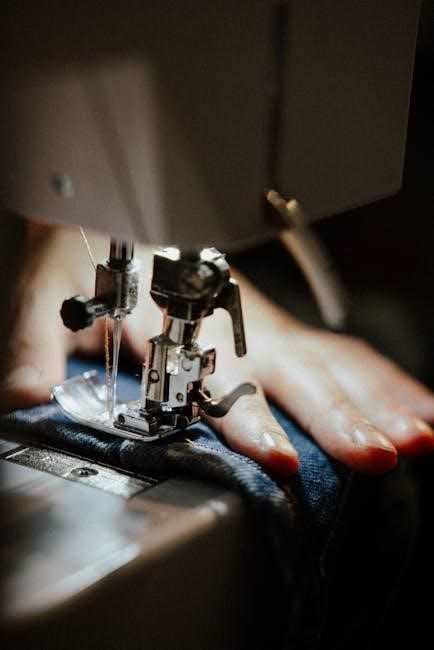
Maintenance and Cleaning
Regularly clean the machine by removing lint and dust from the bobbin area and feed dogs. Oil moving parts as instructed to ensure smooth operation. Avoid inserting sharp objects‚ which could damage internal components. Keep ventilation openings free from debris to prevent overheating and maintain optimal performance.
7.1 Cleaning the Machine and Removing Lint
Start by unplugging the machine for safety. Open the bobbin compartment and gently brush away lint using a small‚ dry brush or compressed air. Clean the feed dogs and surrounding areas with a soft cloth. Avoid using liquids to prevent damage. Regularly removing lint ensures smooth operation and prevents overheating. Always refer to the manual for specific cleaning instructions tailored to your machine model.
7.2 Oiling the Machine for Smooth Operation
Regular oiling is essential for maintaining your sewing machine’s performance. Use only the oil recommended in the manual‚ typically applied to the bobbin area and feed dogs. Gently turn the handwheel to distribute the oil evenly. Sew on scrap fabric to ensure proper lubrication. Over-oiling can attract lint‚ so apply sparingly. Always refer to the manual for specific oiling points and frequency tailored to your machine model.
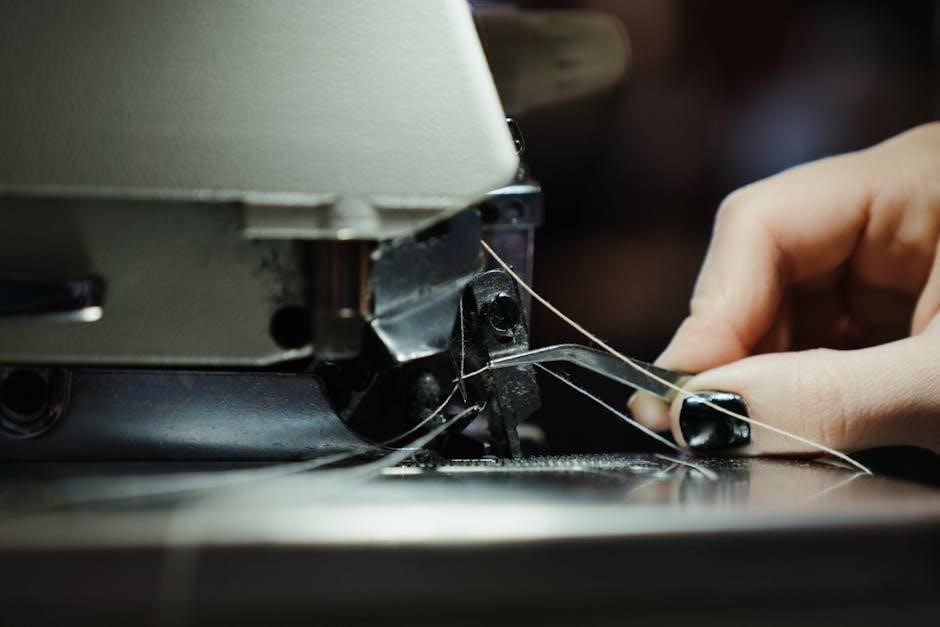
Troubleshooting Common Issues
Troubleshooting common issues ensures smooth operation. Identify problems like thread breakage or machine noise‚ and resolve them using the manual’s guidance and practical sewing tips.
8.1 Thread Breakage and Tension Problems
Thread breakage and tension issues are common challenges. Check for incorrect threading‚ improper tension settings‚ or using the wrong needle size. Ensure the bobbin is correctly wound and seated. If thread breaks frequently‚ inspect for lint buildup or sharp edges inside the machine. Adjust tension dials as per the manual to restore balance and prevent fabric puckering or uneven stitching.
8.2 Machine Noise or Vibration
Excessive noise or vibration may indicate improper setup or maintenance. Ensure the machine is placed on a stable surface and clear of lint or debris. Check needle alignment and verify the bobbin is correctly installed. If issues persist‚ oil moving parts and consult the manual for specific guidance. Regular maintenance can help restore smooth operation and reduce noise levels effectively.
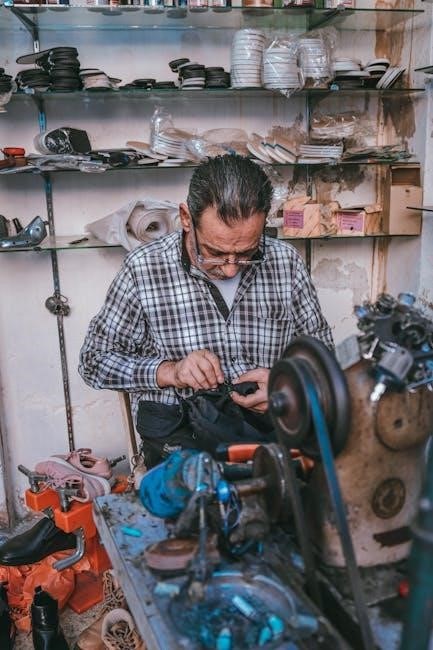
Advanced Sewing Techniques
Explore advanced techniques like sewing buttons‚ buttonholes‚ embroidery‚ and decorative stitching. Use specialized attachments and stitches to create intricate designs and professional finishes for your projects.
9.1 Sewing Buttons and Buttonholes
Sewing buttons and buttonholes is simplified with the New Home Sewing Machine. Use the automatic buttonhole feature for consistent results. Place the button on the fabric‚ align it under the buttonhole foot‚ and sew. For manual buttonholes‚ use the zigzag stitch. Reinforce seams with backstitching for durability. The machine’s precision ensures professional-looking buttons and buttonholes for garments‚ upholstery‚ or crafts.
9.2 Embroidery and Decorative Stitches
The New Home Sewing Machine offers a variety of decorative stitches and an embroidery mode‚ allowing for intricate designs. Use the stitch selector to choose patterns like floral motifs or geometric shapes. Adjust stitch length and width for customization. For embroidery‚ stabilize fabric with interfacing and use the embroidery foot for precise control. Create beautiful‚ professional-looking designs with ease and precision.
Specialized Attachments and Their Uses
Explore the Zipper Foot for precise zipper installation and the Blind Hem Foot for invisible hems. These attachments enhance your sewing experience‚ offering professional results for various projects.
10.1 Using the Zipper Foot for Purses and Bags
The Zipper Foot is ideal for sewing zippers in purses and bags‚ ensuring precise alignment and control. Its narrow design allows smooth navigation along the zipper teeth‚ preventing fabric bunching. Use it to install zippers neatly and evenly‚ achieving professional-looking results for your DIY projects. It’s perfect for thick materials and heavy-duty sewing tasks.
10.2 Sewing with the Blind Hem Foot
The Blind Hem Foot is designed for creating nearly invisible hems on fabrics like trousers‚ skirts‚ and curtains. It’s perfect for garment alterations and home decor projects. This attachment guides the fabric precisely‚ ensuring even stitching. It helps achieve professional-looking results with minimal effort‚ making it ideal for both beginners and experienced sewists.
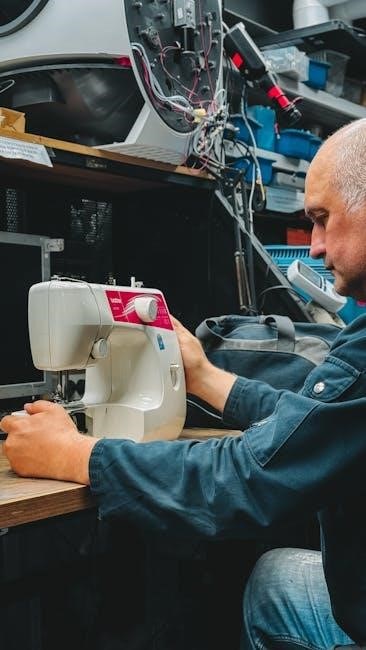
Sewing Machine Storage and Transportation
Store your New Home Sewing Machine in a dry‚ cool place‚ using a protective cover to prevent dust buildup. Transport it securely in its original case to avoid damage.
11.1 Proper Storage Conditions
Store your New Home Sewing Machine in a clean‚ dry environment to prevent rust and damage. Use a protective cover to shield it from dust and moisture. Maintain a consistent temperature between 60°F and 80°F (15°C to 27°C) to ensure optimal performance. Avoid direct sunlight or extreme humidity to preserve the machine’s functionality and longevity. Always store it in its original case or a sturdy‚ padded bag for added protection.
11.2 Transporting the Machine Safely
When transporting your New Home Sewing Machine‚ use the original case or a sturdy‚ padded bag to protect it from scratches and damage. Handle the machine with care to avoid drops. Keep it upright to prevent internal mechanisms from shifting. Secure it during travel to prevent movement. Ensure the area is dry to avoid moisture exposure‚ and check for dust upon arrival to maintain performance.

Warranty and Customer Support
Your New Home Sewing Machine comes with a warranty covering parts and labor for a specified period. For inquiries or assistance‚ contact customer support via phone‚ email‚ or the official website. Refer to the manual for detailed warranty terms and support contact information to ensure optimal service and maintenance.
12.1 Understanding the Warranty Terms
The New Home Sewing Machine warranty covers parts and labor for a specified period‚ typically one to five years‚ depending on the model. It protects against manufacturing defects but excludes damage from misuse or normal wear. Review the manual for exact terms‚ as some components may have shorter coverage periods. Understanding these terms ensures proper maintenance and protects your investment;
12.2 Contacting Customer Support
For assistance with your New Home Sewing Machine‚ contact customer support via phone or email as listed in the manual. They provide help with troubleshooting‚ repair inquiries‚ and warranty-related questions. Ensure to have your machine model number ready for efficient service. Online resources and downloadable manuals are also available for quick reference and self-guided solutions.
Downloading and Accessing Digital Manuals
Digital manuals for the New Home Sewing Machine are available for free download as PDF files. Visit authorized websites or manufacturer portals to access instructions‚ ensuring convenience and easy reference for troubleshooting and maintenance.
13.1 Finding the Correct Manual for Your Model
To find the correct manual for your New Home Sewing Machine‚ identify your model number and visit the official manufacturer website or verified sources. Use specific search terms like “New Home 532 sewing machine manual” or “New Home XL-II manual” for accurate results. Ensure the manual matches your machine model for proper guidance and safety instructions.
13.2 Tips for Navigating the PDF Manual
Use the table of contents in the PDF manual to quickly locate sections. Employ the search function with specific terms like “threading” or “troubleshooting” for instant access. Bookmark frequently used pages and adjust the zoom for readability. Print relevant sections if needed‚ and take notes in the margins for personal reference. This ensures efficient navigation and easy access to essential information.

Common Mistakes to Avoid
14.1 Incorrect Threading Techniques
Avoid improperly threading the machine‚ as it leads to uneven stitches or thread breakage. Always follow the manual’s guidelines for correct threading techniques to ensure smooth operation.
Incorrect threading is a common mistake that can lead to uneven stitches or thread breakage. Always follow the manual’s threading guide to ensure proper needle and bobbin setup. Using low-quality thread or neglecting to cut excess thread can also cause issues. Regularly check for lint buildup and ensure the take-up lever is in the correct position. Proper threading ensures smooth operation and prevents damage to the machine.
14.2 Overloading the Machine with Thick Fabric
Overloading the machine with thick fabrics can cause uneven stitching‚ thread breakage‚ or even damage to internal components. Avoid sewing multiple heavy layers or dense materials like thick denim without using the appropriate presser foot. Always test fabric thickness and use the machine’s built-in features or specialized feet to handle heavier fabrics safely and effectively.
Mastering your New Home Sewing Machine requires practice and patience. Experiment with different fabrics and stitches to explore its full potential. Refer to the manual for troubleshooting and maintenance tips to ensure long-lasting performance and enjoy creating timeless sewing projects with confidence and creativity.
15.1 Encouragement to Practice and Experiment
Embrace creativity and explore the full potential of your New Home Sewing Machine. Practice regularly to master various stitches and techniques. Experiment with different fabrics and attachments to discover new possibilities. Don’t hesitate to try innovative projects—every stitch brings you closer to sewing excellence. Use the manual as a guide and troubleshooting resource to overcome challenges and create unique‚ personalized projects with confidence.
15.2 Resources for Further Learning
Enhance your sewing skills with online tutorials‚ downloadable guides‚ and community forums. Visit the official New Home website for detailed manuals and video instructions. Join sewing groups to share ideas and learn from experienced users. Explore creative projects and troubleshooting tips to expand your sewing expertise and stay updated on the latest techniques and machine updates.